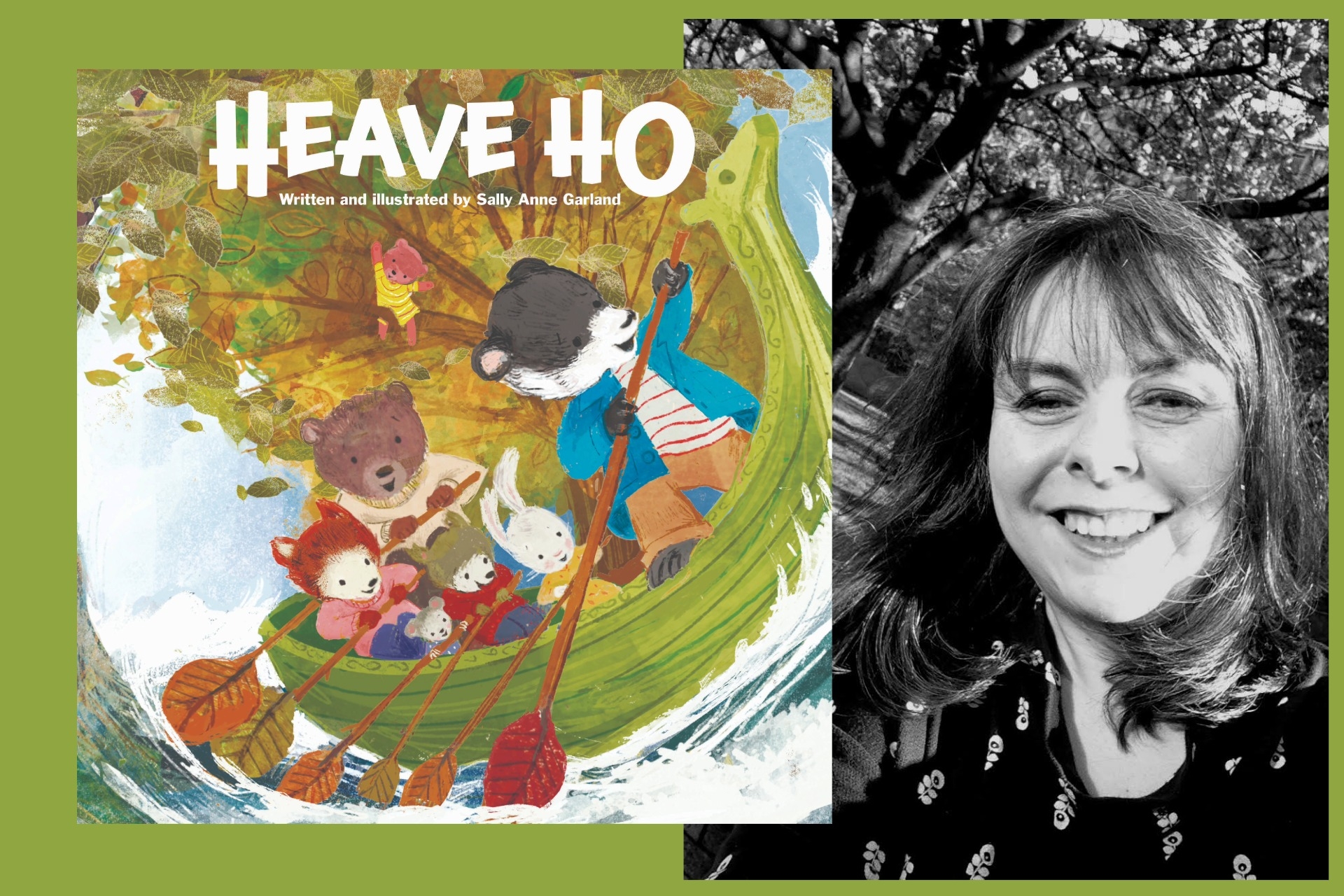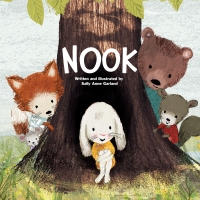In this insightful Q&A we hear from Sally Anne Garland the author behind Heave Ho, a warm and perceptive picture book that gently explores the emotional turbulence young children can feel, and the surprising power of play in helping them regulate and reset. Through a familiar school playground setting and a cast of relatable, diverse characters, the story opens up vital conversations around neurodiversity, inclusion and emotional wellbeing without ever lecturing or labelling. Here, the author shares the inspirations behind Heave Ho, the quiet power of nature and sensory play, and why there are no grown-ups on the page - just children, feelings, and a tree.
Q. Heave Ho is the perfect story to discuss big feelings with young children. Has personal experience inspired you to create the book?
A. I think I was just really conscious of keeping it simple—just creating a little story about essentially play, especially sensory play, that doesn't tell the reader what’s happening, but shows it in a way they can hopefully see themselves or others in.
All kids, be they neurotypical, neurodiverse or just simply having a bit of a tough time experience the emotional rollercoaster of growing up. For kids who see or experience the world differently, those ups and downs can be particularly more intense.
Sensory play—like swinging from ropes, climbing trees, or digging in the dirt—is a natural and intuitive way for all kids to regulate their emotions. It helps them feel their way into a better frame of mind, calm their nervous systems when overstimulated, and ultimately find their own sense of agency.
There’s a reason why playgrounds exist. It’s not just for fun (though there’s plenty of that), it’s because climbing, jumping, swinging...these simple activities universally help young children reset thoughts and emotions that are out of sync, in ways words often can’t. That is, until they fall off a swing or climbing frame—and we have yet another big feeling!
In Heave Ho, I wanted to gently open up conversations about big feelings and why some young children might seem to be acting out or behaving differently in a way that is relatable to children or even helps a child to find ways to process their own big feelings.
I’ve done this by setting the story in a familiar place, with characters and situations children might even recognise from their own classrooms or playgrounds.
I have also made play the central theme in the story. Play is a child’s first language and one they all recognise. It is a way their bodies, even before their minds, can begin to understand and process things. When we show that we all need to play differently, we invite understanding, acceptance and inclusion of differences.
Some will swing on a branch, others will flap and spin and some just need to squeeze in to tight spaces, but they are all doing essentially the same thing, balancing and regulating a young nervous system. There are no rules to playing except it makes us feel good.
The characters in both Nook and Heave Ho experience the world differently. Each has their own internal struggles to balance, and so their play on the same tree—the setting for both stories—is different. Each character plays in their own unique way, and each for different reasons.
Q. Tell us a little bit about Cub, the central character, and his friends.
A. Cub is overwhelmed by big, unexplained feelings. Maybe it’s sensory overload. Maybe it’s emotional, like something troubling him at home. He certainly doesn’t know himself and it’s intentionally left open, so the reader can interpret it in their own way.
These feelings cause Cub to act out towards his classmates. But with the help of a sturdy tree branch, Cub finds a way to regulate those emotions. Swinging becomes his way of transforming the storm inside—he imagines himself at the helm of a ship, steering back to calm, connection, and friendship.
I purposely set this story in the same place as Nook. The tree in the playground is the same one. It’s a safe, accepting place where characters with all sorts of struggles can come together and be themselves.
I hope to write further stories about the other characters too - Flick, Ossie, Moss and Rhu - each will have their own differences, each playing on the tree in their own way, and each with a different story to tell.
Q. The story could prepare children as they go to school or return to class but all the action is set outside. Why?
A. Cub finds the classroom overwhelming, and the tree in the playground offers him the quiet space he needs to ground himself again.
The playground in both Heave Ho and Nook is very idealised. For a start there is no fence—only trees and open grassland. It’s a fictional space where nature calms children and miraculously resets their minds so their thoughts are clearer and their nervous systems are ready for the classroom. If only it was that easy.
To some extent, playgrounds in schools can do this but I am only too aware reality isn’t always so perfect. I think most teachers would tell you this. I think they would also tell you that the classroom size and the environment aren’t ideal for a significant number of their class.
But perhaps that’s the point of stories—to create places we hope to find, even if they don’t quite exist in the real world just now, at least they exist in books and stories.
Q. There are no adults in your story. Why?
A. I rarely include adults in my stories, and I don’t quite know why. I think I prefer my stories to be on equal footing with the reader, rather than coming from a place higher than them. When I visualise the illustrations, I do tend to think of myself from the point of view of being in the picture with them. As if I am one of the characters and not as an adult. It’s like I am on a stage acting a part with them.
I try to meet children in their own world as an equal, allowing them to interpret the story and form their own thoughts and opinions. Childhood offers so few places that are truly your own—but stories, imagination and play can be among them.
Q. The end papers are beautiful. Please tell us about them.
A. Yes, endpapers are often overlooked in picture books but can be a real opportunity to set the stage and tone for the story—before it’s even begun. I’ll admit, I tend to leave them to the last last-minute though. But I suppose, that's what they are—end papers.
In Heave Ho, I used them to set the emotional mood of the story’s journey: a stormy sea at the start, and a calm sea at the end. You might also notice, in some of the early spreads particularly the classroom ones, that the settings seem to seesaw up and down. I wanted to suggest the motion of a ship, as if the characters are trying to keep their balance with each turn of the page.
Q. What did you like to read as a child?
A. I looked more than I read. I was always telling stories through drawing rather than reading. I was that kid in my second year of primary school who, in her story jotter, would use the blank top half of the page to draw elaborate and dramatic scenes—dragons, mystical lands, my house on fire (which was cause for concern for some adults if I remember)—and then write a cursory “I like my mum and dad” in the lined section below, just to keep the teacher happy.
The books I particularly loved when I was older were AA Milnes’s Winnie the Pooh stories. I’m not sure what drew me to them as a child, but I reread The House at Pooh Corner recently while writing Heave Ho. It struck me how it is not necessarily just about different personalities all trying to get along but rather a group of characters thinking about the world in their own individual ways and could be easily viewed through the lens of neurodivergence, even if AA Milne did not intend to write it that way.
“Owl,” said Rabbit shortly, “you and I have brains. The others have fluff.”
Rabbit thinks having "brain" makes him better but in truth, the "fluff" he dismisses holds the woods and community together. I love how Milne shows and endears different kinds of thinking and characteristics but doesn’t tell or pathologize. These are all characters who, despite perhaps their more annoying traits, are incredibly human and likeable.
I think it would be a great book to kick off and engage kids in a conversation about neurodiversity.
Q. Where and how do you work?
A. don’t really have a fixed place or method. I sometimes work at a table in our local library—funnily enough, it’s in the crime section. I write stories for children while surrounded by books about death and crime which is a bit odd when you think about it. However, there is a great kid’s section next door where I can look at the new books and listen to small voices chatter while I work - sometimes they even sing a little too which is nice.
Getting to the library also involves a bit of a constitutional walk through our local park. I do most of my thinking while walking, shopping, or washing up. I’m always on the lookout for quirks in the everyday—those tiny things that would catch a child’s attention.
I also have a table in our bedroom that looks out over a lovely communal garden space. That’s where I often draw and listen to podcasts. It’s where the idea for The Chalk Garden was inspired, looking out this window at two kids drawing in chalk.





Comments (0)
Leave A Reply
You must be logged in to post a comment.